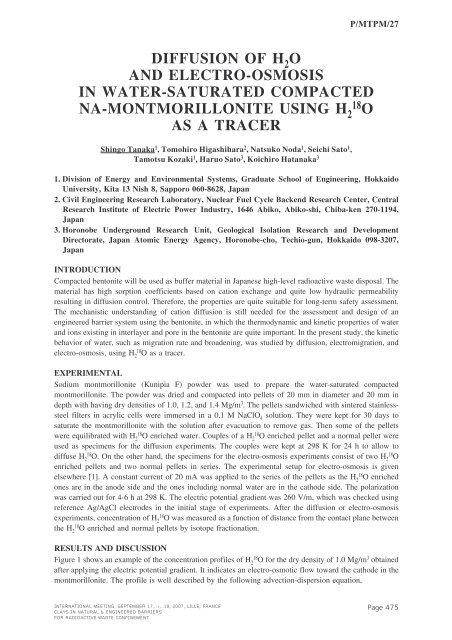Mass Transfer & Porous Media (MTPM) - Andra
Mass Transfer & Porous Media (MTPM) - Andra
Mass Transfer & Porous Media (MTPM) - Andra
Create successful ePaper yourself
Turn your PDF publications into a flip-book with our unique Google optimized e-Paper software.
P/<strong>MTPM</strong>/27DIFFUSION OF H 2 OAND ELECTRO-OSMOSISIN WATER-SATURATED COMPACTEDNA-MONTMORILLONITE USING H 2 18 OAS A TRACERShingo Tanaka 1 , Tomohiro Higashihara 2 , Natsuko Noda 1 , Seichi Sato 1 ,Tamotsu Kozaki 1 , Haruo Sato 3 , Koichiro Hatanaka 31. Division of Energy and Environmental Systems, Graduate School of Engineering, HokkaidoUniversity, Kita 13 Nish 8, Sapporo 060-8628, Japan2. Civil Engineering Research Laboratory, Nuclear Fuel Cycle Backend Research Center, CentralResearch Institute of Electric Power Industry, 1646 Abiko, Abiko-shi, Chiba-ken 270-1194,Japan3. Horonobe Underground Research Unit, Geological Isolation Research and DevelopmentDirectorate, Japan Atomic Energy Agency, Horonobe-cho, Techio-gun, Hokkaido 098-3207,JapanINTRODUCTIONCompacted bentonite will be used as buffer material in Japanese high-level radioactive waste disposal. Thematerial has high sorption coefficients based on cation exchange and quite low hydraulic permeabilityresulting in diffusion control. Therefore, the properties are quite suitable for long-term safety assessment.The mechanistic understanding of cation diffusion is still needed for the assessment and design of anengineered barrier system using the bentonite, in which the thermodynamic and kinetic properties of waterand ions existing in interlayer and pore in the bentonite are quite important. In the present study, the kineticbehavior of water, such as migration rate and broadening, was studied by diffusion, electromigration, andelectro-osmosis, using H 2 18 O as a tracer.EXPERIMENTALSodium montmorillonite (Kunipia F) powder was used to prepare the water-saturated compactedmontmorillonite. The powder was dried and compacted into pellets of 20 mm in diameter and 20 mm indepth with having dry densities of 1.0, 1.2, and 1.4 Mg/m 3 . The pellets sandwiched with sintered stainlesssteelfilters in acrylic cells were immersed in a 0.1 M NaClO 4 solution. They were kept for 30 days tosaturate the montmorillonite with the solution after evacuation to remove gas. Then some of the pelletswere equilibrated with H 2 18 O enriched water. Couples of a H 2 18 O enriched pellet and a normal pellet wereused as specimens for the diffusion experiments. The couples were kept at 298 K for 24 h to allow todiffuse H 2 18 O. On the other hand, the specimens for the electro-osmosis experiments consist of two H 2 18 Oenriched pellets and two normal pellets in series. The experimental setup for electro-osmosis is givenelsewhere [1]. A constant current of 20 mA was applied to the series of the pellets as the H 2 18 O enrichedones are in the anode side and the ones including normal water are in the cathode side. The polarizationwas carried out for 4-6 h at 298 K. The electric potential gradient was 260 V/m, which was checked usingreference Ag/AgCl electrodes in the initial stage of experiments. After the diffusion or electro-osmosisexperiments, concentration of H 2 18 O was measured as a function of distance from the contact plane betweenthe H 2 18 O enriched and normal pellets by isotope fractionation.RESULTS AND DISCUSSIONFigure 1 shows an example of the concentration profiles of H 2 18 O for the dry density of 1.0 Mg/m 3 obtainedafter applying the electric potential gradient. It indicates an electro-osmotic flow toward the cathode in themontmorillonite. The profile is well described by the following advection-dispersion equation,INTERNATIONAL MEETING, SEPTEMBER 17...>...18, 2007, LILLE, FRANCECLAYS IN NATURAL & ENGINEERED BARRIERSFOR RADIOACTIVE WASTE CONFINEMENTPage 475
















